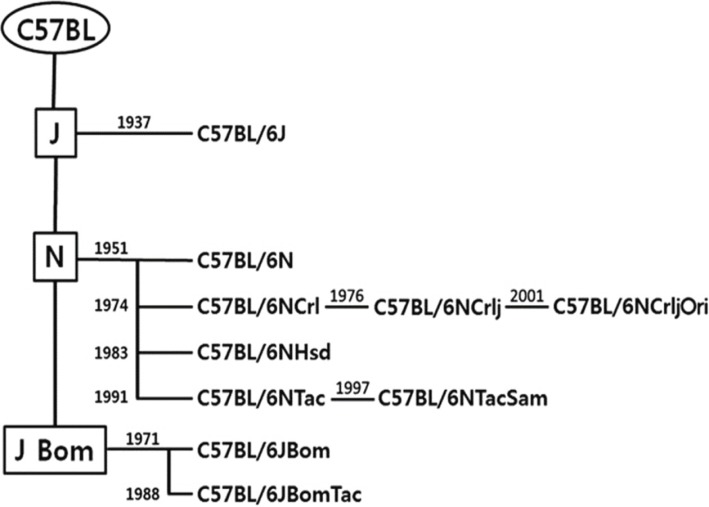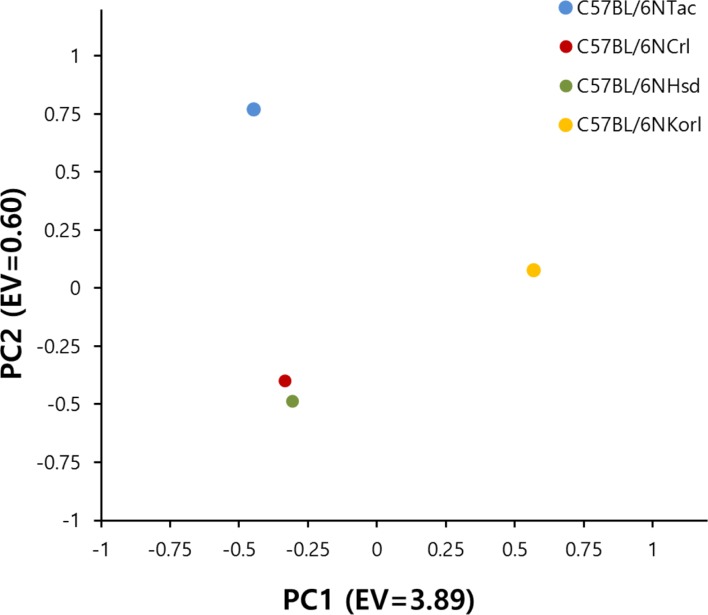Lab Anim Res.
2017 Jun;33(2):119-123. 10.5625/lar.2017.33.2.119.
Use of C57BL/6N mice on the variety of immunological researches
- Affiliations
-
- 1Department of Microbiology and Immunology, INJE University College of Medicine, Busan 47392, Korea. kali71@hanmail.net
- 2Department of Biomaterials Science, College of Natural Resources & Life Science/Life and Industry Convergence Research Institute, Pusan National University, Miryang 50463, Korea. dyhwang@pusan.ac.kr
- KMID: 2407425
- DOI: http://doi.org/10.5625/lar.2017.33.2.119
Abstract
- Inbred mice are an essential animal strain for research as they can improve the reproducibility and reliability of study results. The establishment of new inbred lines is continuing, and new inbred lines are being used in many research fields. C57BL/6 is a mouse laboratory animal that has been developed and used as an inbred strain since early stage of mouse strain development, and, in the 1950s, C57BL/6 was separated into substrains by the Jackson Laboratory (C57BL/6J) and the National Institutes of Health (C57BL/6N). C57BL/6 mice have been used in immunology and antitumor activity studies since the early strain development stage. After the mouse genome was fully described, C57BL/6 mice use in many areas of research has expanded. In particular, immunological characteristics such as those related to cell-mediated immunity and NK cell activity are relatively higher in C57BL/6 mice than in other mice. The C57BL/6NKorl is a stock of C57BL/6N established as part of a localization of experimental animal strategy of the Korean Food and Drug Administration. Based on analysis of single nucleotide polymorphisms (SNPs), C57BL/6NKorl is considered a genetically distinct inbred stock from other C57BL/6N. Various research efforts have been made to describe the characteristics and increase knowledge of the characteristics of C57BL/6Nkorl. The results obtained through these efforts are expected to increase the utilization of C57BL/6Nkorl as a domestic laboratory animal resource and to enhance the reliability of mouse based studies.
MeSH Terms
Figure
Reference
-
1. Festing MF. Properties of inbred strains and outbred stocks, with special reference to toxicity testing. J Toxicol Environ Health. 1979; 5(1):53–68. PMID: 423306.
Article2. WRIGHT S. The genetics of vital characters of the guinea pig. J Cell Comp Physiol. 1960; 56(Suppl 1):123–151.
Article3. Wade CM, Daly MJ. Genetic variation in laboratory mice. Nat Genet. 2005; 37(11):1175–1180. PMID: 16254563.
Article4. Barros SF, Friedlanskaia I, Petricevich VL, Kipnis TL. Local inflammation, lethality and cytokine release in mice injected with Bothrops atrox venom. Mediators Inflamm. 1998; 7(5):339–346. PMID: 9883969.5. Crawley JN, Belknap JK, Collins A, Crabbe JC, Frankel W, Henderson N, Hitzemann RJ, Maxson SC, Miner LL, Silva AJ, Wehner JM, Wynshaw-Boris A, Paylor R. Behavioral phenotypes of inbred mouse strains: implications and recommendations for molecular studies. Psychopharmacology (Berl). 1997; 132(2):107–124. PMID: 9266608.
Article6. Harris RB, Mitchell TD, Yan X, Simpson JS, Redmann SM Jr. Metabolic responses to leptin in obese db/db mice are strain dependent. Am J Physiol Regul Integr Comp Physiol. 2001; 281(1):R115–R132. PMID: 11404285.
Article7. Kile BT, Mason-Garrison CL, Justice MJ. Sex and strain-related differences in the peripheral blood cell values of inbred mouse strains. Mamm Genome. 2003; 14(1):81–85. PMID: 12532271.
Article8. Madiehe AM, Hebert S, Mitchell TD, Harris RB. Strain-dependent stimulation of growth in leptin-treated obese db/db mice. Endocrinology. 2002; 143(10):3875–3883. PMID: 12239099.9. Nishina PM, Wang J, Toyofuku W, Kuypers FA, Ishida BY, Paigen B. Atherosclerosis and plasma and liver lipids in nine inbred strains of mice. Lipids. 1993; 28(7):599–605. PMID: 8355588.
Article10. Opsahl ML, McClenaghan M, Springbett A, Reid S, Lathe R, Colman A, Whitelaw CB. Multiple effects of genetic background on variegated transgene expression in mice. Genetics. 2002; 160(3):1107–1112. PMID: 11901126.
Article11. Rossmeisl M, Rim JS, Koza RA, Kozak LP. Variation in type 2 diabetes--related traits in mouse strains susceptible to diet-induced obesity. Diabetes. 2003; 52(8):1958–1966. PMID: 12882911.
Article12. Sellers RS, Clifford CB, Treuting PM, Brayton C. Immunological variation between inbred laboratory mouse strains: points to consider in phenotyping genetically immunomodified mice. Vet Pathol. 2012; 49(1):32–43. PMID: 22135019.13. van Bogaert MJ, Groenink L, Oosting RS, Westphal KG, van der Gugten J, Olivier B. Mouse strain differences in autonomic responses to stress. Genes Brain Behav. 2006; 5(2):139–149. PMID: 16507005.
Article14. Woodworth CD, Michael E, Smith L, Vijayachandra K, Glick A, Hennings H, Yuspa SH. Strain-dependent differences in malignant conversion of mouse skin tumors is an inherent property of the epidermal keratinocyte. Carcinogenesis. 2004; 25(9):1771–1778. PMID: 15105299.
Article15. Green MC, Grueneberg H, Hertwig P, Heston WE, Lyon MF, Medvedev NN, Snell GD, Staats J. A revision of the standardized genetic nomenclature for mice. J Hered. 1963; 54:159–162. PMID: 14057864.16. Silver LM. Mouse genetics: concepts and applications. New York: Oxford University Press;1995. p. 3–31.17. Dux A, Mhlbock O, Bailey DW. Genetic analyses of differences in incidence of mammary tumors and reticulum cell neoplasms with the use of recombinant inbred lines of mice. J Natl Cancer Inst. 1978; 61(4):1125–1129. PMID: 212568.18. Eppig JT, Blake JA, Bult CJ, Kadin JA, Richardson JE. Mouse Genome Database Group. The mouse genome database (MGD): new features facilitating a model system. Nucleic Acids Res. 2007; 35(Database issue):D630–D637. PMID: 17135206.
Article19. Mekada K, Abe K, Murakami A, Nakamura S, Nakata H, Moriwaki K, Obata Y, Yoshiki A. Genetic differences among C57BL/6 substrains. Exp Anim. 2009; 58(2):141–149. PMID: 19448337.
Article20. Zurita E, Chagoyen M, Cantero M, Alonso R, Gonzlez-Neira A, Lpez-Jimnez A, Lpez-Moreno JA, Landel CP, Bentez J, Pazos F, Montoliu L. Genetic polymorphisms among C57BL/6 mouse inbred strains. Transgenic Res. 2011; 20(3):481–489. PMID: 20506040.
Article21. Derhovanessian E, Solana R, Larbi A, Pawelec G. Immunity, ageing and cancer. Immun Ageing. 2008; 5:11. PMID: 18816370.
Article22. McVicar DW, Winkler-Pickett R, Taylor LS, Makrigiannis A, Bennett M, Anderson SK, Ortaldo JR. Aberrant DAP12 signaling in the 129 strain of mice: implications for the analysis of gene-targeted mice. J Immunol. 2002; 169(4):1721–1728. PMID: 12165492.
Article23. Malhotra A, Shanker A. NK cells: immune cross-talk and therapeutic implications. Immunotherapy. 2011; 3(10):1143–1166. PMID: 21995569.
Article24. Mayer A, Lilly F, Duran-Reynals ML. Genetically dominant resistance in mice to 3-methylcholanthrene-induced lymphoma. Proc Natl Acad Sci U S A. 1980; 77(5):2960–2963. PMID: 6930679.
Article25. Waldhauer I, Steinle A. NK cells and cancer immunosurveillance. Oncogene. 2008; 27(45):5932–5943. PMID: 18836474.
Article26. Talmadge JE, Meyers KM, Prieur DJ, Starkey JR. Role of natural killer cells in tumor growth and metastasis: C57BL/6 normal and beige mice. J Natl Cancer Inst. 1980; 65(5):929–935. PMID: 6933263.27. Corbett AJ, Coudert JD, Forbes CA, Scalzo AA. Functional consequences of natural sequence variation of murine cytomegalovirus m157 for Ly49 receptor specificity and NK cell activation. J Immunol. 2011; 186(3):1713–1722. PMID: 21187440.
Article28. Dokun AO, Kim S, Smith HR, Kang HS, Chu DT, Yokoyama WM. Specific and nonspecific NK cell activation during virus infection. Nat Immunol. 2001; 2(10):951–956. PMID: 11550009.
Article29. Boehm T. Design principles of adaptive immune systems. Nat Rev Immunol. 2011; 11(5):307–317. PMID: 21475308.
Article30. Chen J, Flurkey K, Harrison DE. A reduced peripheral blood CD4(+) lymphocyte proportion is a consistent ageing phenotype. Mech Ageing Dev. 2002; 123(2-3):145–153. PMID: 11718808.
Article31. Chen J, Harrison DE. Quantitative trait loci regulating relative lymphocyte proportions in mouse peripheral blood. Blood. 2002; 99(2):561–566. PMID: 11781239.
Article32. Glineur S, Antoine-Moussiaux N, Michaux C, Desmecht D. Immune depression of the SJL/J mouse, a radioresistant and immunologically atypical inbred strain. Immunobiology. 2011; 216(1-2):213–217. PMID: 20965099.
Article33. Karamitros D, Kotantaki P, Lygerou Z, Kioussis D, Taraviras S. T cell proliferation and homeostasis: an emerging role for the cell cycle inhibitor geminin. Crit Rev Immunol. 2011; 31(3):209–231. PMID: 21740351.
Article34. Pepper M, Jenkins MK. Origins of CD4(+) effector and central memory T cells. Nat Immunol. 2011; 12(6):467–471. PMID: 21739668.
Article35. Mills CD, Kincaid K, Alt JM, Heilman MJ, Hill AM. M-1/M-2 macrophages and the Th1/Th2 paradigm. J Immunol. 2000; 164(12):6166–6173. PMID: 10843666.
Article36. Ministry of Food and Drug Safety. Establishement for the stock of the domestic laboratory animals. Annu Rep 2015.
- Full Text Links
- Actions
-
Cited
- CITED
-
- Close
- Share
- Similar articles
-
- Compensatory role of C3 convertase on the strain difference for C3 protein expression in FVB/N, C3H/HeN and C57BL/6N mice
- Comparative study of the immunological characteristics of three different C57BL/6N mouse substrains
- Concurrent response to challenge infection with Cryptosporidium parvum in immunosuppressed C57BL/6N mice
- Comparison of humoral and cell-mediated immunity in three different C57BL/6N mouse substrains
- Comparative study of fertilization rates of C57BL/6NKorl and C57BL/6N mice obtained from two other sources



